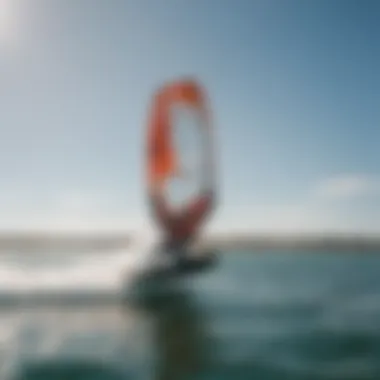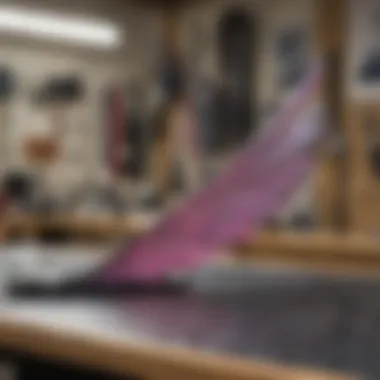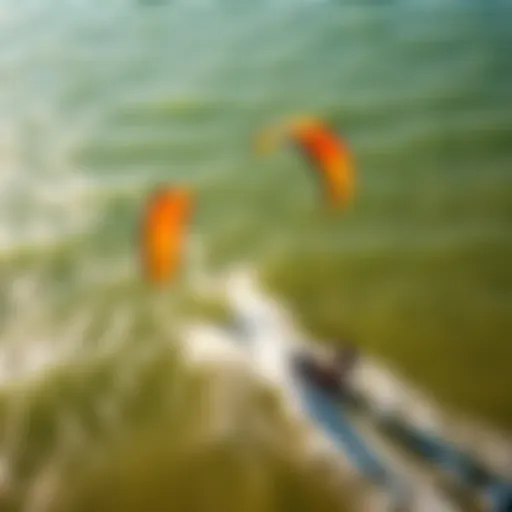Exploring Liquid Force Foil Wings in Kiteboarding


Intro
Kiteboarding has traveled quite the journey, evolving from its early days into a sport bursting with technology and innovation. One highlight of this evolution is the Liquid Force foil wings, a game changer that has surged in popularity among enthusiasts. Understanding these wings is not just about knowing their function; it’s about grasping how they redefine the riding experience, offering unmatched performance on the water.
Liquid Force, known for its forward-thinking approach, has designed these wings with the serious kiteboarder in mind. They blend intricate design with advanced materials, impacting not only speed but also agility and stability. With a little know-how, even someone new to kiteboarding can tap into the benefits these foil wings provide.
This piece will take you on a detailed exploration of these liquid wonders. From gear selection to skill development, we'll cover everything necessary to give you a solid foundation. Whether you're an instructor, competitor, or casual rider, this guide will deepen your understanding and appreciation of Liquid Force foil wings.
Gear Selection
Before hitting the waves, it’s crucial to choose the right setup which complements your foil wings. Doing so can make a world of difference in your performance.
Types of Kites
Choosing the right kite is like picking the perfect tool for a job. Different kites suit different conditions. Consider the following:
- C-Shape Kites: Great for power and precision, ideal for aggressive maneuvers.
- Delta Kites: Known for ease of use and stability in various wind conditions.
- Bow Kites: Offer excellent depower and large wind ranges, making them perfect for beginners.
Your choice of kite should factor in the wind conditions and your riding style. A little research can lead to an informed decision that aligns with your goals.
Choosing the Right Board
Just as important as kites are the boards under your feet. The board should enhance your control and compliments the wing’s capabilities. Here are a couple of considerations:
- Board Size: Larger boards provide better floatation and ease of use in lighter winds. Smaller boards enhance performance in stronger winds and allow for quick movements.
- Material: Boards made with carbon fiber tend to be lighter and more responsive. However, those made with foam encapsulation might be easier to handle for newcomers.
Selecting the right board in conjunction with your Liquid Force foil wing will significantly boost your overall riding experience, allowing for smoother transitions and sharper turns.
Skill Development
Mastering the art of kiteboarding requires attention to skill development. It’s not just about how fast you can go, but how well you maneuver and control your craft.
Essential Techniques
When you’re out on the water, it’s key to practice techniques that marry your skill level with the performance of your foil wings. Here are a few vital techniques to focus on:
- Body Positioning: Your stance heavily affects how your kite reacts. Keep your weight centered, and maintain a low center of gravity for improved stability.
- Wing Control: Managing the foil wing effectively can change how efficiently you ride. Learning to handle the lift and drag will enhance your overall performance.
Progression Tips
As you get comfortable with your setup, consider these tips for progression:
- Experiment with Conditions: Don’t shy away from different weather. This builds versatility and confidence.
- Progressive Learning: Tackle new challenges in sequence. If jumps are your goal, master your turns first.
Learning is a journey. Every ride has lessons. Embrace each wave and wind.
With consistent practice and attention to the intricacies of your gear, you’ll find yourself progressing further than you thought possible.
Understanding Liquid Force foil wings isn’t simply about technical specs; it’s a pathway toward enhanced performance on water. Grasping the core elements of gear selection and skill development can greatly enhance your kiteboarding experience, keeping you riding high.
Preamble to Foil Wings
Foil wings are more than just a new gadget in kiteboarding; they represent a paradigm shift in how riders engage with the water. Understanding foil wings is crucial for anyone looking to not only improve their performance but to also genuinely appreciate the nuances of this thrilling sport. These wings, designed to lift the rider above the water's surface, provide an unparalleled experience that combines speed and fluidity.
When it comes to kiteboarding, the dynamics of water can be as unpredictable as they are invigorating. This is where foil wings shine. They minimize drag and maximize lift, allowing riders to harness even the slightest breeze. The ability to glide over water while experiencing minimal resistance creates a unique thrill that many enthusiasts find intoxicating.
Definition of Foil Wings
Foil wings, at their core, are specialized hydrofoils that extend below the water's surface. These wings consist of a mast, fuselage, and the wing itself. The hydrofoil elevates the board above water, allowing the rider to fly above the surface when enough speed is attained. This design takes full advantage of hydrodynamics, creating lift as the wing moves through the water. The lifted position enables smoother rides, reduces board-to-water turbulence, and eases the strain on the rider.
When considering what makes these wings so effective, it's vital to note their shapes and materials. Wing shapes can vary significantly, with different designs optimizing lift and maneuverability to cater to various styles and conditions. While larger wings are often ideal for beginners wanting stability and ease of use, smaller wings cater to more advanced riders seeking speed and responsiveness.
History and Evolution of Foil Technology
The journey of foil technology is a fascinating reflection of innovation in water sports. Initially, the concept of hydrofoiling wasn't mainstream. Early designs appeared in the first half of the 20th century but did not gain traction until much later. Over time, developments in materials and aerodynamics spurred the evolution of these wings, making them lighter and stronger.
The late 1990s marked a pivotal change in the history of foil boarding, particularly as kiteboarding began to take off. Innovations in design led to more stable and efficient wings, allowing riders to embrace faster speeds and enhanced maneuverability. With each new iteration and feedback from riders, designers worked tirelessly to perfect the foil experience. Liquid Force has been at the forefront of these advancements, leading to the performance we witness in their foil wings today.
As technology continues to evolve, the future of foil wings is bright. With cutting-edge materials and designs under continual exploration, one can expect even greater advancements in lift dynamics and rider comfort. Those engaged in kiteboarding today are not just partaking in a sport; they are also part of a rich history that is progressing rapidly.
"The duality of foil wings lies in their performance and the intimate connection created between rider and water. Understanding this relationship is fundamental to mastering kiteboarding."
In summary, grasping the intricacies of foil wings not only amplifies a rider’s skill set but also enriches their overall kiteboarding experience. This host of knowledge sets the groundwork for exploring the breadth of Liquid Force as a leading brand in kiting, next.


Overview of Liquid Force
Liquid Force has carved out a significant niche in the kiteboarding industry. Understanding this company is crucial, as it plays a pivotal role in shaping the equipment used by riders of all levels. By exploring its evolution, innovations, and commitments, one gains a clearer picture of why Liquid Force is synonymous with quality and performance in the kiteboarding community.
Company Background
Founded in 1995, Liquid Force began as a vision to revolutionize watersports through innovative equipment. The founders were passionate riders who wanted better gear. With a focus on quality and performance, Liquid Force quickly gained traction. They didn’t just aim to create products; they sought to enhance the overall experience. This hands-on approach runs deep in Liquid Force culture. Today, it’s a well-known brand among kiteboarding enthusiasts worldwide.
What sets the company apart is its commitment to rider feedback. Liquid Force actively involves riders in the design process. This ensures that their equipment meets the real-world demands of those using it. Whether the user is a novice or a seasoned pro, Liquid Force products are designed to deliver results.
Key Innovations in Kiteboarding Equipment
Liquid Force isn’t just a participant in the kiteboarding realm; it’s a pioneer. Their continuous innovations have raised the bar for kiteboarding gear. Here are several ways in which they’ve made their mark:
- Foil Technology: Liquid Force has been at the forefront of developing advanced foil technology. Their foil wings are crafted using sophisticated designs that enhance lift and reduce drag. This ensures a smoother ride and better performance, especially in lighter winds.
- Material Advancements: Materials play a critical role in kiteboarding gear. Liquid Force has invested heavily in researching and sourcing high-strength, lightweight materials. These materials not only improve the durability of the wings but also ensure that they perform optimally.
- User-Centric Design: Understanding that kitesurfing is not a one-size-fits-all sport, Liquid Force has developed various shapes and sizes of foil wings. This allows riders to choose gear tailored to their style and riding conditions.
“Innovations in design and materials can reshape not just the ride, but the entire kiteboarding experience.”
- Durability Features: The rigorous conditions of the ocean require equipment that can withstand wear and tear. Liquid Force has integrated technologies to ensure the longevity of their foil wings. Features such as reinforced seams and UV-resistant finishes materialize from their focus on quality.
Understanding the significance of Liquid Force and their commitment to innovation ultimately reveals the importance of their products in the kiteboarding community. Their willingness to adapt and grow with rider needs is not just a marketing tagline but a core philosophy that defines their approach to manufacturing top-notch kiteboarding equipment.
Design Features of Liquid Force Foil Wings
When diving into the world of kiteboarding, the design features of Liquid Force foil wings stand as a cornerstone in enhancing performance and ensuring an unrivaled experience on the water. This segment will illuminate vital elements like wing shapes and sizes, material composition, and construction techniques that collectively optimize maneuverability and efficiency. Understanding these facets can empower riders to make informed decisions that align with their individual preferences and riding styles.
Wing Shapes and Sizes
The shape and size of a foil wing dictate how it interacts with water and air, affecting lift, drag, and speed. Liquid Force offers a variety of wing designs suitable for various conditions and rider abilities.
- Surface Area: Larger wings generally provide more lift, making them ideal for lighter wind conditions. Conversely, smaller wings enhance speed and agility, perfect for seasoned riders who desire a more dynamic ride.
- Aspect Ratio: Wings with a high aspect ratio allow for better speed and reduced drag, ideal for swift maneuvers. On the other hand, low aspect ratio wings provide more stability and lift at lower speeds, useful for beginners learning the ropes.
- Profile: The curvature of the wings impacts their performance. A thicker profile aids in quick lift, while a slimmer design excels at slicing through the air, offering increased performance.
Understanding these features can help kiteboarders select the right wing configuration for their skills and the conditions they face.
Material Composition
The materials used in foil wing construction greatly influence performance, durability, and overall rider experience. Liquid Force blends innovation with proven materials to ensure their foil wings withstand the rigors of the sport.
- Carbon Fiber: Known for its lightweight yet incredibly strong properties, carbon fiber is a go-to for premium performance wings. It stiffens the wing structure, allowing for better responsiveness in turns and jumps.
- Fiberglass: More cost-effective than carbon, fiberglass still provides excellent performance while being more forgiving in terms of flex. It's ideal for recreational riders seeking durability without breaking the bank.
- Foam Core: Many modern wings incorporate foam cores, which significantly reduce weight while enhancing buoyancy. This feature contributes to easier lift-off and better glide.
Each material serves a purpose and can dramatically affect how a rider feels while on the water. Understanding the differences can guide consumers toward the choice that best suits their needs.
Construction Techniques
The methods employed in constructing Liquid Force foil wings are as critical as the materials used. These techniques can influence performance metrics and longevity.
- Molding: Liquid Force utilizes sophisticated molding techniques to create seamless structures. Molded wings minimize imperfections and reduce drag, leading to improved aerodynamics.
- Layering: By applying multiple layers of materials, Liquid Force enhances strength and durability. This process allows for the creation of wings that can endure impacts and stresses encountered in various water conditions.
- Precision Engineering: Every wing is crafted with meticulous attention to detail, ensuring that each element contributes to optimal performance. This precision translates into consistent uplift and an enjoyable ride.
When selecting a foil wing, knowledge of these construction techniques can be invaluable. Riders can assess which specific designs and manufacturing processes align with their aspirations and riding styles.
"The beauty of kiteboarding lies not just in the thrill but in the connection between rider, wind, and water — and the right foil wing enhances that dance."
In closing, the design features of Liquid Force foil wings are intricately tied to rider performance and satisfaction. Familiarity with these elements enhances the decision-making process, enabling kiteboarders to choose wings that resonate with their unique riding experiences.
Performance Characteristics
The realm of performance characteristics in Liquid Force foil wings is critical to understanding how these equipment elevate kiteboarding beyond mere recreation. Riders often seek tools that not only enhance their enjoyment but also optimize their performance on the water. This section will dive into the intricacies of lift and drag dynamics, maneuverability, responsiveness, and stability. Each component plays a vital role in shaping the overall riding experience, offering various benefits and considerations for both novice and seasoned kiteboarders.
Lift and Drag Dynamics
The relationship between lift and drag is fundamental in the world of foil wings. A well-designed wing will generate a significant amount of lift while minimizing drag. Lift refers to the upward force that allows the rider to glide above the water, essential for achieving speed and breadth of movement. To put it simply, when a kiteboarder increases speed, the lift produced also tends to rise, allowing for smoother transitions and ascents.
On the other hand, drag is the enemy of efficiency. It refers to the opposing force that slows the rider down due to friction and resistance with the water. Liquid Force has engineered its foil wings to reduce drag significantly, optimizing their shape and surface materials.
A few key considerations about lift and drag dynamics are:
- Wing shape: An elongated profile can improve lift but may increase drag if not balanced correctly.
- Surface texture: Smooth finishes optimize flow, reducing turbulence and drag.
- Angle of attack: The angle at which the wing meets the water determines lift efficiency.
Understanding how these elements interplay can help riders select the foil wing best suited to their style.
Maneuverability and Responsiveness
Maneuverability is the art of the dance on the water. The essence lies in how quickly and effectively a foil wing can respond to a rider’s inputs. Liquid Force's designs cater to different skill levels, ensuring that everyone can experience a heightened sense of responsiveness.
A foil wing that boasts excellent maneuverability allows for snappy turns, quick pivots, and smooth transitions from one move to the next. For the rider, this translates into a more exhilarating experience. Here are some features contributing to better maneuverability:


- Aspect ratio: Higher aspect ratios typically improve speed but may decrease turnability.
- Wing flexibility: A degree of flex can absorb the impact of turbulent waters, providing a smoother ride.
- Tail design: A well-crafted tail helps facilitate turns while maintaining control.
Responsive foil wings can feel almost like an extension of the rider, allowing for nimble adjustments, aiding in tackling wind shifts and unexpected conditions.
Stability in Varied Conditions
Stability is paramount when it comes to tackling shifting winds and unpredictable water surfaces. The Liquid Force foil wings are designed with specific features that create stability, making them reliable in diverse environments. A stable wing reduces the risk of falling, even for those venturing into rougher conditions.
Key factors influencing stability include:
- Wing loading: A balanced wing loading allows for consistent lift across various conditions.
- Center of gravity: A lower center of gravity enhances stability, preventing excessive tilting.
- Reinforced structures: Robust construction can withstand impacts without compromising the wing’s shape.
By choosing a foil wing that emphasizes stability, riders can focus more on mastering their techniques, knowing their gear won’t betray them even when conditions get choppy or unpredictable.
In summary, the performance characteristics of Liquid Force foil wings significantly influence the kiteboarding experience, providing vital elements that enhance the overall ride while allowing for individual rider preferences and conditions.
Advantages of Using Liquid Force Foil Wings
Understanding the advantages of using Liquid Force foil wings is crucial for anyone involved in kiteboarding. As this sport constantly evolves, the gear used can often be the deciding factor between a mediocre experience and an exhilarating one. Liquid Force has carved a niche in creating foil wings that not only enhance performance but also add layers of enjoyment and safety for riders. Let’s delve into these advantages, each revealing how they contribute to a better kiteboarding experience.
Enhanced Speed and Glide Efficiency
One of the main draws of Liquid Force foil wings is their remarkable speed and glide efficiency. The design of these wings allows for reduced drag, giving riders the ability to slice through water with minimal resistance. This increased efficiency translates into greater speed, enabling kiteboarders to harness the wind better.
When a rider is properly aligned with the kite and the foil wing, they experience a sensation akin to gliding through the air rather than battling against the waves. The wings’ contours are finely tuned, designed to maximize lift while retaining stability. Consequently, even during challenging transitions, the rider feels a cohesive connection with both the board and the wind.
"Efficient glide means less effort and more time enjoying the ride."
This efficiency not only benefits experienced riders striving for speed but also beginners who might struggle with standard setups. Some might notice improvements in their overall riding experience even during calmer sessions. With Liquid Force foil wings, less becomes more.
Improved Performance in Light Winds
Kiteboarding enthusiasts know the frustration of light wind days. Riding in such conditions often leaves many feeling like they’re missing out on the sport they love. However, the Liquid Force foil wings change the game entirely.
Designed to perform optimally in marginal wind, these wings can lift riders efficiently even with minimal airflow. The construction focuses on feather-light materials that contribute to the wings' responsiveness. As a result, kiteboarders can experience smooth rides when conditions aren’t at their best.
Many riders report that they can stay up and riding in wind conditions as low as 10-12 knots. The innovation in design allows for a kitesurfing experience that might have been dismissed on a still day. Those who enjoy long rides can truly take advantage of this aspect, making the most out of what nature provides.
Rider Experience and Comfort
The Liquid Force foil wings not only improve performance metrics but also elevate the overall rider experience. Comfort in kiteboarding should never be an afterthought, and Liquid Force seems to understand this intuitively. These wings are crafted with ergonomics in mind, providing consistent feedback to the rider during maneuvers while ensuring minimal fatigue.
The materials chosen for these foil wings offer both flexibility and strength, which dampens the harshness when encountering challenging water conditions. As a result, riders report feeling more at ease during their sessions, allowing them to focus on technique instead of discomfort.
Furthermore, adjustments can be made easily to suit individual preferences or to adapt to changing conditions, further personalizing the experience. Riders thus feel empowered to explore their limits without being hindered by excessive physical strain.
To encapsulate, Liquid Force foil wings provide significant benefits influencing a rider's performance and enjoyment. Wind conditions, speed, comfort — these elements coalesce to craft a well-rounded experience on the water. Whether you're a novice or a seasoned kiteboarder, selecting the right wing can open doors to a new realm of riding.
Finale
Understanding these advantages helps kiteboarders not only choose the right equipment but also appreciate the technology behind their rides. Investing in Liquid Force foil wings may just be the game-changer many riders have been seeking.
Selecting the Right Liquid Force Foil Wing
Selecting the right foil wing is like finding the perfect pair of shoes; it greatly impacts your overall kiteboarding experience. The Liquid Force foil wings are engineered with precision, ensuring that they cater to various riding styles and conditions. Picking the right wing not only enhances your performance but also ensures safety on the water. Having the right fit can make a world of difference whether you are skimming across flat water or tackling choppy waves.
Factors to Consider
When choosing a Liquid Force foil wing, consider the following factors that can make or break your ride:
- Wing Size
The size of the wing plays a crucial role in lift and drag. A larger wing often means more lift but can also feel less maneuverable. Conversely, a smaller wing may be quicker but require more speed to generate lift. Tailor your choice to your skill level and the conditions you plan to ride in. - Aspect Ratio
Higher aspect ratio wings are typically more efficient at speed and provide smoother gliding, while lower aspect ratios are generally more stable and easier to maneuver. Think about whether you want to cruise or carve. - Material
Different materials contribute to the wing's weight, durability, and performance. Lightweight materials may increase speed but might sacrifice some durability. It’s about striking that balance between how you ride and the wear and tear your gear will endure. - Riding Style
Are you more into racing, freestyle, or simply cruising? Your riding style should dictate the wing’s configuration. Styles like freestyle require wings that can respond quickly to commands, while racing may benefit from wings designed for maximum efficiency.
By assessing these factors, you can find a Liquid Force foil wing that harmonizes with your personal riding style and the specifics of the environment in which you ride.
Common Mistakes to Avoid
Choosing the right wing can be tricky, and errors in judgement can lead to frustrating rides. Here are a few common pitfalls to steer clear of:
- Ignoring Conditions
Every day on the water is not the same. Selecting a wing without considering wind conditions may lead to a less-than-ideal experience. Always check the forecast before heading out. - Overestimating Skill Level
Newer riders may rush into buying a complex wing thinking it’ll enhance their skills immediately. It’s better to start with something manageable and grow into more technical setups as your abilities improve. - Neglecting Proper Testing
Failing to test different models before purchasing can be a costly mistake. A wing may look good on paper but feels entirely different on the water. Find an opportunity to demo a few options to see what fits.
"The difference between a good ride and a great ride often lie in the details of your gear choice."
- Underestimating the Importance of Compatibility
Not all wings work with all boards. Ensure your chosen wing is compatible with your existing set-up to avoid nasty surprises later on. Do your research on sizes and connections.
Navigating the sea of choices can feel overwhelming, but using these insights will help you select a Liquid Force foil wing that elevates your kiteboarding game.


Maintenance and Care
When it comes to Liquid Force foil wings in kiteboarding, maintaining the equipment is crucial to ensuring both longevity and performance. These wings are designed to handle various environmental challenges but, like any gear, they require proper care to function optimally. By taking the time to clean, store, and inspect your foil wings, not only do you enhance their lifespan, you also ensure safer and more enjoyable rides on the water.
Cleaning and Storage Techniques
Cleaning your foil wing after each session is key to preserving its quality. Saltwater and sand can cause wear over time, leading to degradation of both material and performance. Here are some simple yet effective cleaning techniques:
- Rinse with fresh water right after use to remove salt and sand settlements.
- Use a soft cloth or sponge to gently scrub any stubborn debris, ensuring you don’t scratch the surface.
- Allow the wing to air dry completely before storage, avoiding damp areas which can lead to mold and mildew growth.
- Store away from direct sunlight to prevent material deterioration caused by UV rays.
When it comes to storage, consider a few critical factors. Find a cool, dry place, ideally in a protective bag, to keep your foil wing safe. Storing them sprawled out can prevent creasing and stretching. A well-organized setup helps prevent accidental bumps that can cause damage.
Inspections for Wear and Tear
Regular inspections are essential. Over time, usage naturally leads to wear and tear, making it important to catch potential issues early. Here are a few inspection tips:
- Check for dings and dents: After each use, inspect the wings for any visible signs of damage. Even small dings can affect performance, particularly in higher speeds.
- Examine attachments and fittings: Ensure all screws, straps, and connections are secure. Loose components can lead to bigger issues, especially when you’re out in the water, away from immediate help.
- Inspect the surface material: Look for any cracks, tears, or frayed edges. The fabric should feel intact and resilient – if it appears thin or tattered, it might be time for a repair or replacement.
In summary, maintenance and care of your Liquid Force foil wings is not just about extending their life; it's about ensuring each kiteboarding session is as thrilling and safe as possible. The effort you put into these simple practices can vastly improve your overall experience on the water.
"A little care goes a long way. By taking the time to look after your equipment, you’re investing in countless memorable rides ahead."
Safety Considerations with Foil Wings
When engaging in kiteboarding with foil wings, ensuring safety on the water is paramount. Foil wings, like the ones produced by Liquid Force, offer exhilarating experiences but also come with their own set of hazards. Riders must be acutely aware of their surroundings and take precautions to minimize risks.
Notably, foil wings are characterized by their elevated stance above the water, which can lead to less visibility of other water users. Thus, it becomes essential for riders to engage in clear communication and awareness of all factors influencing safety, such as wind conditions, other riders, and even aquatic life.
Identifying Hazards and Risks
Various risks accompany the thrill of kiteboarding with foil wings. Among the prominent hazards are:
- Collision Risks: Riders often share the water with other kitesurfers, jet skis, and boats. Not keeping an eye on fellow athletes can lead to unexpected accidents.
- Environmental Hazards: Objects submerged under the water—like rocks, reefs, or debris—can pose a serious threat if not identified ahead of time. Riders need to know the area they are practicing in.
- Wind Changes: Winds can shift suddenly, impacting how a foil wing behaves. Understanding wind patterns and using devices like barometers can provide insights into impending changes.
- Equipment Failure: Regular inspection of all gear is imperative. A compromised wing or faulty line can lead to situational danger, so being diligent about maintenance is key.
"Being aware of your environment and your equipment can be the difference between an exhilarating ride and an unforeseen accident."
Best Practices for Safe Riding
Implementing best practices enhances both safety and enjoyment while riding foils:
- Conduct Pre-Ride Checks: Always inspect your gear before hitting the water. Look for wear spots or frayed lines, and ensure the wing is inflated properly.
- Know Your Limits: Understanding personal skills and the conditions at hand can prevent strategies that are too risky. If conditions feel too challenging, consider sitting it out or switching to a beach day.
- Stay Clear of Crowds: Avoid areas where multiple watercraft or riders are gathered. More bodies on the water increase the probability of accidents.
- Utilize Safety Systems: Make full use of the safety features and systems in your paddle, including quick-release mechanisms. Having these features at the ready offers an extra layer of security.
- Communicate Clearly: If kiteboarding with friends, establish signals to indicate maneuvers or changes in direction. Staying in constant communication can dismantle potential hazards.
By following these practices, kiteboarders using Liquid Force foil wings can significantly reduce their chances of facing mishaps while enhancing their overall experience on the water.
Future of Foil Wing Technology
The evolution of foil wing technology stands at a crucial juncture. Innovators are pushing boundaries, exploring new materials and design philosophies that could redefine kiteboarding experiences. Understanding these developments not only elevates the sport but also helps riders make informed gear choices that can enhance their performance on the water.
Emerging Trends in Design and Materials
The landscape of foil wing design is undergoing a transformation with the advent of advanced materials and innovative structural concepts. Carbon fiber has become a favored choice, prized for its strength-to-weight ratio, allowing for lighter and more responsive wings. This shift not only enhances performance but also gives riders a better feel for the water.
- Sustainable Materials: With an increasing focus on the environment, manufacturers are experimenting with eco-friendly composites. These materials provide similar performance characteristics as traditional options while minimizing ecological impact.
- Modular Designs: There's a trend towards modular wings, allowing riders to customize their setups. This adaptability is key, as it caters to varying wind conditions and skill levels, making the technology more accessible.
- Aerodynamic Shapes: The shapes of wings are becoming more specialized. Designers are focusing on wings that offer unique profiles for different riding styles. For instance, a wing with a pronounced leading edge might excel in upwind performance, while a broader, flatter wing can provide stability during downwind rides.
"The future of foil wing technology is not just about performance but also about sustainability and rider personalization."
Impact on the Kiteboarding Landscape
As these innovations surface, the implications for the kiteboarding community are profound. Increased performance capability translates to new techniques and tricks, altering the competitive scene.
- Broader Participation: Enhanced designs can make kiteboarding more approachable for beginners. As gear becomes lighter and easier to handle, more people might take to the water, expanding the sport's reach.
- Competitive Edge: In competitions, advancements in foil technology can create a significant divide between adept riders and those still utilizing older gear. This further encourages a cycle of innovations to gain competitive advantages among participants.
- Influence on Learning: As the capabilities of foil wings improve, so too will the learning curve for new kiteboarders. With the right wing, a rider can leverage the lift and glide efficiency needed to master the basics, fundamentally shortening the timeline for progression.
In summary, the future of foil wing technology is intertwined with ongoing research, innovative materials, and a growing focus on sustainability. It promises a rich tapestry of advancements that will shape the kiteboarding experience well into the future.
Closure
As we wrap up our comprehensive exploration of Liquid Force foil wings, it's crucial to reflect on how these innovative pieces of equipment fundamentally enhance the kiteboarding experience. Understanding the nuances presented throughout this article grants kiteboarders, instructors, and enthusiasts the clarity they need to maximize their engagement with foil wings.
Summarizing the Liquid Force Foil Wing Experience
Liquid Force foil wings provide an unparalleled advantage on the water. With their unique designs and advanced materials, riders can expect significant improvements in lift and performance. The emphasis on efficiency and stability has transformed the way kiteboarders engage with their environment. These wings glide seamlessly, offering a sensation akin to flying just above the surface, which many riders describe as exhilarating.
To summarize, the key benefits of Liquid Force foil wings include:
- Enhanced maneuverability: The wings allow for sharp turns and minimal drag, which is a game changer for skilled kiteboarders looking to push their limits.
- Improved stability: With a design that accounts for a wide range of conditions, riders can feel secure even when the wind shifts unexpectedly.
- Rider comfort: The lightweight construction reduces fatigue while maximizing performance, ensuring that riders can enjoy longer sessions without compromise.
Encouragement for Continued Learning
The journey with Liquid Force foil wings doesn't end with understanding their mechanics or benefits. Continuous learning is vital in this dynamic sport. As technology evolves, so does the array of techniques and styles associated with kiteboarding. Staying informed and embracing new information can lead to better practices and improved safety on the water.
Consider diving into kiteboarding forums like reddit.com or engaging with communities on facebook.com where kiteboarders share valuable insights and experiences. Participating in workshops and clinics, be it in-person or virtual, can also equip riders with skills that may not be covered in traditional settings. Ultimately, the evolution of kiteboarding gear like the Liquid Force foil wings serves not just to enhance performance but also to encourage a culture of learning and discovery in the sport.















